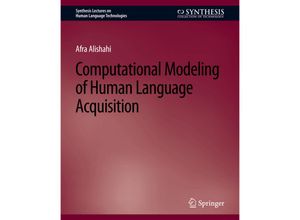Human language acquisition has been studied for centuries but using computational modeling for
such studies is a relatively recent trend. However computational approaches to language
learning have become increasingly popular mainly due to advances in developing machine
learning techniques and the availability of vast collections of experimental data on child
language learning and child-adult interaction. Many of the existing computational models
attempt to study the complex task of learning a language under cognitive plausibility criteria
(such as memory and processing limitations that humans face) and to explain the developmental
stages observed in children. By simulating the process of child language learning
computational models can show us which linguistic representations are learnable from the input
that children have access to and which mechanisms yield the same patterns of behaviour that
children exhibit during this process. In doing so computational modeling provides insight into
the plausible mechanisms involved in human language acquisition and inspires the development
of better language models and techniques. This book provides an overview of the main research
questions in the field of human language acquisition. It reviews the most commonly used
computational frameworks methodologies and resources for modeling child language learning and
the evaluation techniques used for assessing these computational models. The book is aimed at
cognitive scientists who want to become familiar with the available computational methods for
investigating problems related to human language acquisition as well as computational
linguists who are interested in applying their skills to the study of child language
acquisition. Different aspects of language learning are discussed in separate chapters
including the acquisition of the individual words the general regularities which govern word
and sentence form and the associations between form and meaning. For each of these aspects
the challenges of the task are discussed and the relevant empirical findings on children are
summarized. Furthermore the existing computational models that attempt to simulate the task
under study are reviewed and a number of case studies are presented. Table of Contents:
Overview Computational Models of Language Learning Learning Words Putting Words Together
Form--Meaning Associations Final Thoughts

